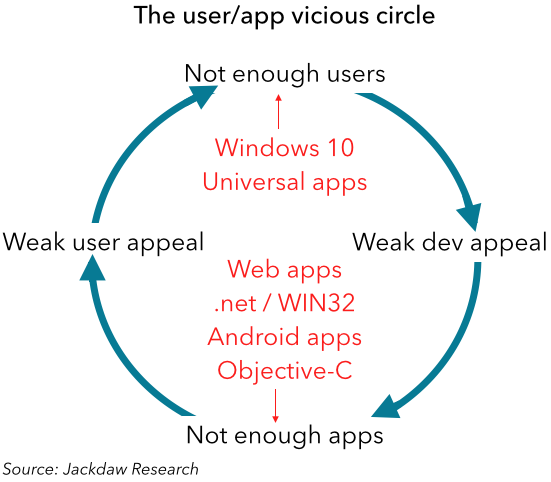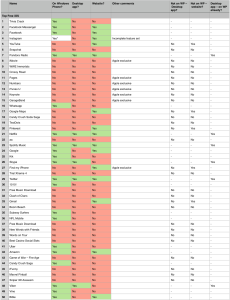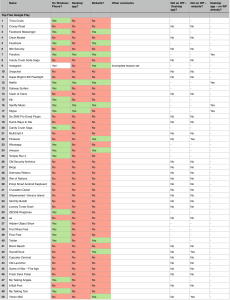Microsoft today announced a restructuring of its devices business which I think most of us have been expecting to land any day since CEO Satya Nadella’s memo to employees a couple of weeks ago indicating tough choices were ahead (and indeed, which the company strongly hinted might be coming back in April). However, even though this was widely anticipated, the exact meaning of it is less obvious. I see many taking it as a capitulation, but Microsoft clearly isn’t getting out of the phone business at this point. Below are my thoughts on what this move means, and what might still come later.
Not a concession of defeat – yet
Though clearly a concession that things haven’t been going well for its devices business, this isn’t a concession of total defeat just yet, and there are two reasons why I say that:
- Microsoft accounts for almost all Windows Phone device sales itself, with over 95% of the market according to AdDuplex. As such, killing its own devices business would simultaneously kill Windows Phone as a platform
- Microsoft’s positioning around Windows 10 has had a heavy mobile component, with universal apps and various tools for porting apps from other mobile platforms major focus areas in the announcements over the last several months. As such, it seems extremely unlikely that Microsoft would be ready to kill off Windows Phone.
In short, the timing just doesn’t seem right for abandoning either Microsoft’s first party phone business or Windows Phone as a whole. That’s not what’s happening today, though that doesn’t mean it’s not coming somewhere down the line, as I discuss below.
Windows 10 and focus
It’s clear that at least some within the business believe that Windows 10 and some of the related efforts targeted at developers will help to turn the fortunes of Windows Phone around. I’ve shared my skepticism about that hope in several pieces here over the last few months (including the two linked to in that second bullet above), and wrote an in-depth report about Windows Phone and its prospects too (available here). I continue to believe that Windows Phone suffers from several more or less insurmountable challenges, and don’t see any clear way out of this situation even with Windows 10.
At least part of the problem with Windows Phone has been that it was losing money at its current scale and that scale wasn’t growing rapidly enough to make a difference. By scaling down the business still further, Microsoft likely shifts the equation slightly in favor of profitability, though at the rate the feature phone business has been declining, that may not be enough. But the focus Microsoft is planning to bring to its portfolio is a good thing – for such a small devices business, Microsoft (and Nokia before it) has had a bewildering array of devices on sale, and could likely get by with a much smaller number, say one or two in each of its series (500, 600, 700 etc). But amid this “focus” comes this statement reported by Mary-Jo Foley at ZDNet:
Microsoft will focus its phone efforts on three segments: Businesses, value-phone buyers and flagship phone customers, moving forward.
This is a funny kind of focus! As far as the smartphone market is concerned, flagship and value phones are basically all there is at this point in many markets, so that’s no focus at all. And the mention of business users reflects a basic misunderstanding of the phone market which Nokia seemed to have overcome way back, when it abandoned its E-Series devices. The fact is that business users are just the same as anyone else – they want phones they like to use, that allow them to do not just work but personal stuff too. I’m also curious what this all means about the feature phone business and whether Microsoft will now abandon that entirely. There was a theory that being in feature phones would allow Microsoft to provide a migration path to smartphones over time, but I’ve always been skeptical about that, and at the rate of decline this business is seeing, it’s more of a liability than an asset at this point.
Microsoft shrugged
Meanwhile, the impairment charge is so large that it’s hard to imagine that it’s for anything other than the whole value of the business acquired from Nokia. Remember that though the total price paid to Nokia was 5.44 billion euros (reported as $7.2 billion at the time it was announced), only 3.79 billion (or $5 billion) was for the devices business, while the other $2 billion or so was for patents. The $7.6 billion impairment charge is therefore not just more than the original purchase price, but significantly more than the price paid for the devices business specifically. That either means that Microsoft is also writing down some of the value of the patents or accounting for a significant additional investment in the business since the acquisition (or both). However, at the end of the day, the key point is that Microsoft has at this point basically unburdened itself of the value of the acquisition, such that if it does have to wind the business down it likely won’t have to take another significant impairment charge.
By the time it’s done with the layoffs announced today, Microsoft will also have jettisoned around 80% of the employees associated with the Nokia acquisition. It took on around 25,000 (down from the 32,000 originally anticipated) when the acquisition closed, but laid of around half three months later, in July last year. Now, a year later, it’s losing another 7-8,000, taking the remainder down to just 5,000, or 20% of those originally brought on board.
As such, if Microsoft does have to abandon Windows Phone and its own devices business (I simply don’t see how it’s going to get more OEMs on board for Windows Phone, so the two are inextricably linked), at least it’s now written down much of the value of the acquisition, and will have eliminated most of the employees by the end of this year. That will make it much easier financially and operationally (if not emotionally) to pull the plug when the time comes. But it will be a huge sea change for Microsoft to concede defeat in operating systems for mobile devices after 15 years of trying.
Postponing the inevitable
I suspect today’s move is just another step along the road that eventually leads to an abandonment of this business, even if Microsoft isn’t ready to concede defeat today. The good news is that Microsoft has a strong alternative strategy in place with its third party mobile apps business, which has produced some good results recently, so that it’s not putting all its mobile eggs in the Windows Phone basket as in the past. I continue to worry that a third-party apps business may struggle as both Apple and Google increasingly tie their first party services tightly into their operating systems and virtual assistants, but it certainly seems to have a better shot at gaining users than Windows Phone for now.
However, the other big challenge is monetizing that usage, which continues to be my biggest concern for Microsoft. Its traditional software licensing model simply isn’t going to cut it in consumer markets, and I suspect the SaaS model will be equally challenging. As such, as I outlined in my “Thesis on Microsoft” piece a while back, Microsoft is going to have to make its money more or less exclusively through enterprise cloud services while using the consumer market to drive continued scale.


